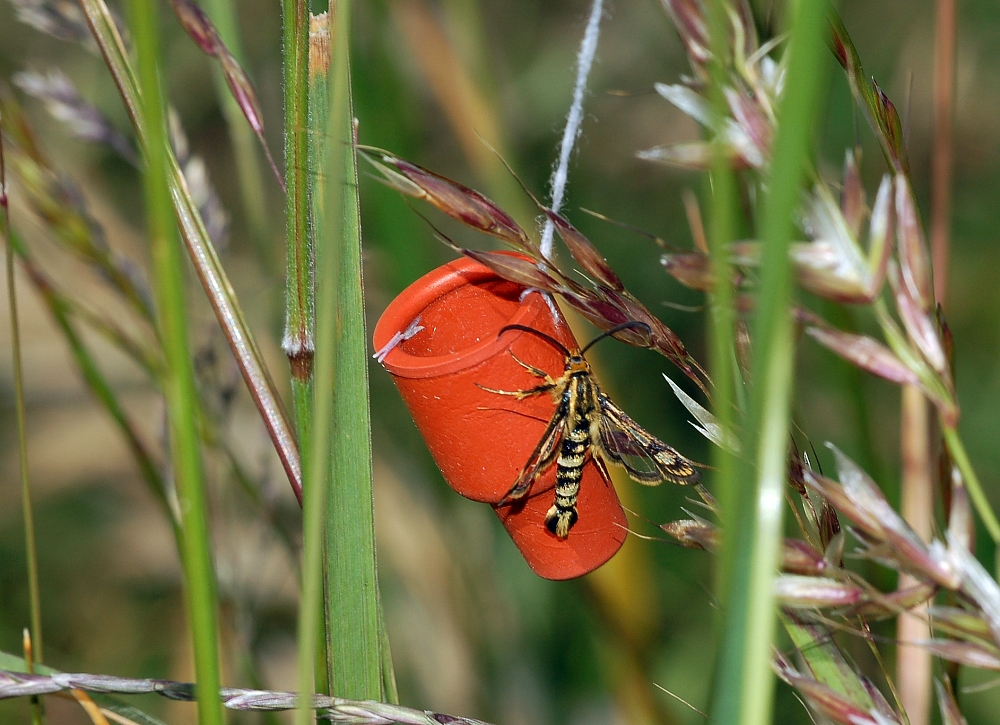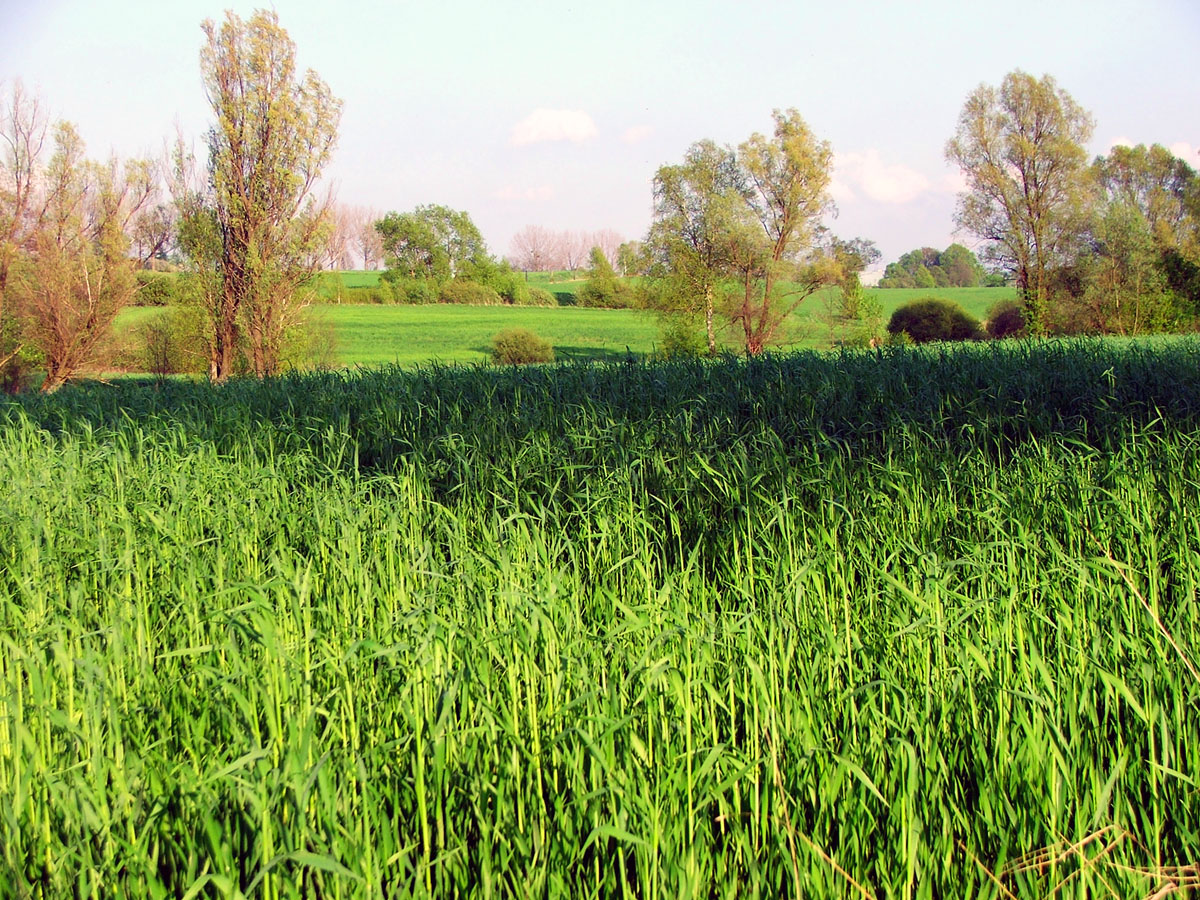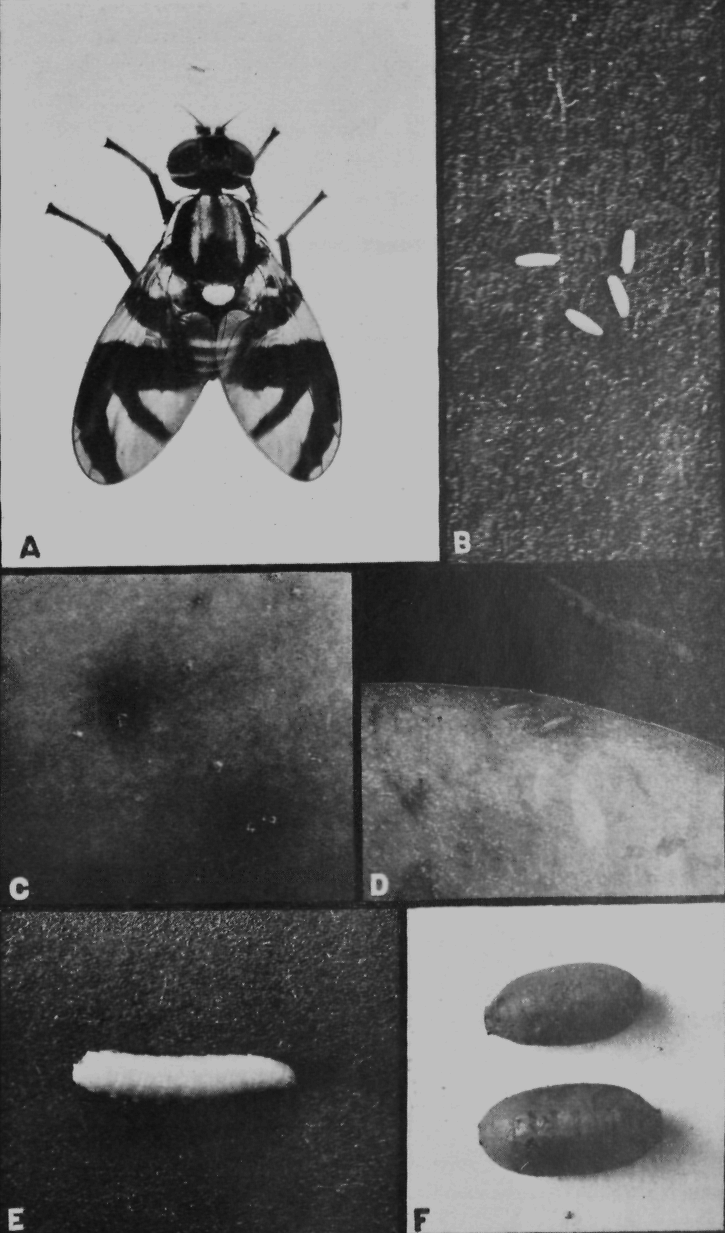|
Pheromone Trap
A pheromone trap is a type of insect trap that uses pheromones to lure insects. Sex pheromones and aggregating pheromones are the most common types used. A pheromone-impregnated lure, as the red rubber septa in the picture, is encased in a conventional trap such as a bottle trap, Delta trap, water-pan trap, or funnel trap. Pheromone traps are used both to count insect populations by sampling, and to trap pests such as clothes moths to destroy them. Sensitivity Pheromone traps are very sensitive, meaning they attract insects present at very low densities. They are often used to detect presence of exotic pests, or for sampling, monitoring, or to determine the first appearance of a pest in an area. They can be used for legal control, and are used to monitor the success of the Boll Weevil Eradication Program and the spread of the gypsy moth. The high species-specificity of pheromone traps can also be an advantage, and they tend to be inexpensive and easy to implement. This sensitivit ... [...More Info...] [...Related Items...] OR: [Wikipedia] [Google] [Baidu] |
Sesiidae Pheromon Fg01
The Sesiidae or clearwing moths are a diurnal moth family in the order Lepidoptera known for their Batesian mimicry in both appearance and behaviour of various Hymenoptera. The family consists of 165 genera spread over two subfamilies, containing in total 1525 species and 49 subspecies, most of which occur in the tropics, though there are many species in the Holarctic region as well, including over a hundred species known to occur in Europe. Morphology Sesiidae are characterized by their hymenopteriform Batesian mimicry, frequently of identifiable species. Most species of Sesiidae have wings with areas where scales are nearly completely absent, resulting in partial, marked transparency. Forewings are commonly elongated and narrow in the basal half. In many species, the abdomen is elongated, with an anal tuft, and striped or ringed yellow, red or white, sometimes very brightly so. Legs are long, thin and frequently coloured, and in some species the hind-legs are elongated. In ... [...More Info...] [...Related Items...] OR: [Wikipedia] [Google] [Baidu] |
African Bollworm
''Helicoverpa armigera'' is a species of Lepidoptera in the family Noctuidae. It is known as the cotton bollworm, corn earworm, Old World (African) bollworm, or scarce bordered straw (the lattermost in the UK, where it is a migrant). The larvae feed on a wide range of plants, including many important cultivated crops. It is a major pest in cotton and one of the most polyphagous and cosmopolitan pest species. It should not be confused with the similarly named larva of the related species ''Helicoverpa zea''. Distribution This species comprises two sub-species: ''Helicoverpa armigera armigera'' is native and widespread in central and southern Europe, temperate Asia and Africa; ''Helicoverpa armigera conferta'' is native to Australia, and Oceania. The former sub-species has also recently been confirmed to have successfully invaded Brazil and has since spread across much of South America and reached the Caribbean. It is a migrant species, able to reach Scandinavia and other northern ... [...More Info...] [...Related Items...] OR: [Wikipedia] [Google] [Baidu] |
Beech Tortrix Moth
''Cydia fagiglandana'', the beech moth, is a moth of the family Tortricidae. Distribution and habitat This species is present in most of Europe. These moths mainly occur in beech woodland. Description ''Cydia fagiglandana'' can reach a wingspan of 12–16 mm. The forewings are brown-black irrorated with whitish, crossed by pairs of fine dark brown stripes. The basal patch is slightly darker, the edge sharply angulated. There are two leaden-metallic streaks from costa posteriorly and a large darker coppery-tinged terminal patch hardly reaching costa. The ocellus within this patch is edged with leaden-metallic, enclosing some blackish marks. The hindwings are fuscous. The larvae are light yellowish or whitish, longitudinally clouded with orange; spots orange; head pale brownish; plate of 2 pale ochreous. This species is rather similar to '' Cydia splendana''. Biology The moth flies from April to September depending on the location. They are active in the evening. The la ... [...More Info...] [...Related Items...] OR: [Wikipedia] [Google] [Baidu] |
Barred Fruit-tree Tortrix
''Pandemis cerasana'', the barred fruit-tree tortrix, is a moth of the family Tortricidae. Distribution This quite common species is found in Europe, from the Iberian Peninsula to the Ural Mountains and the Caucasus, east to southern Siberia, Kazakhstan, Mongolia, China and the Far East. It is also found in Asia Minor and Iran. It is an introduced species in North America. Habitat The ''barred fruit-tree tortrix'' live in woodland areas, gardens and orchards. Description The wingspan of ''Pandemis cerasana'' can reach 16–25 mm. Forewings ground colour ranges from pale ocher yellow to greyish brown with a large dark chestnut brown V marking and a dark brown lateral spot. The outer margin of forewings is sinuous, slightly oblique. The hind wings are almost uniform greyish brown. Antennae of the males have a notch near the base. Larvae can reach a length of about . They are light green, thin and flattened. Pupae are light brown to brownish black and reach a length of . Th ... [...More Info...] [...Related Items...] OR: [Wikipedia] [Google] [Baidu] |
Scolytus Schevyrewi
''Scolytus schevyrewi'', the banded elm bark beetle, is a 3–4 mm long elm bark beetle species in the genus ''Scolytus'' native from Asia and accidentally introduced to North America. It is a vector of the Dutch elm disease, caused by the Ascomycota ''Ophiostoma ulmi'' and ''Ophiostoma novo-ulmi ''Ophiostoma'' is a genus of fungi within the family Ophiostomataceae. It was circumscribed in 1919 by mycologists Hans Sydow and Paul Sydow. Species *''Ophiostoma adjuncti'' *'' Ophiostoma ainoae'' *'' Ophiostoma allantosporum'' *'' Ophiosto ...''. In North America, it is displacing both the native elm bark beetle and the previously introduced smaller European elm bark beetle, which are becoming less common in their range with the expansion of ''S. schevyrewi''. References Scolytinae Insect pests of temperate forests Beetles described in 1802 Taxa named by Andrey Semyonov-Tyan-Shansky {{Scolytinae-stub ... [...More Info...] [...Related Items...] OR: [Wikipedia] [Google] [Baidu] |
Cosmopolites Sordidus
''Cosmopolites sordidus'', commonly known as the banana root borer, banana borer, or banana weevil, is a species of weevil in the family Curculionidae. It is a pest of banana cultivation and has a cosmopolitan distribution, being found in all parts of the world in which bananas are grown. It is considered the most serious insect pest of bananas. Description The adult banana root borer is about in length and has a glossy greyish-black or dark brown appearance. Unlike the billbugs (''Sphenophorus''), the thorax lacks depressions. The tibia of each of the limbs bears an accessory hook-like claw with which the insect clings to plants. The larva is plump and whitish with a reddish-brown head. The eighth abdominal segment of the larva bears a large spiracle, the remaining segments bearing small spiracles; the last two segments appear truncated, being fused together to form a plate-like structure. The pupa has an irregular appearance, with the developing wings and limbs being discerna ... [...More Info...] [...Related Items...] OR: [Wikipedia] [Google] [Baidu] |
Asian Corn Borer Moth
''Ostrinia furnacalis'' is a species of moth in the family Crambidae, the grass moths. It was described by Achille Guenée in 1854 and is known by the common name Asian corn borer since this species is found in Asia and feeds mainly on corn crop. The moth is found from China to Australia, including in Java, Sulawesi, the Philippines, Borneo, New Guinea, the Solomon Islands, and Micronesia. The Asian corn borer is part of the species complex, ''Ostrinia'', in which members are difficult to distinguish based on appearance. Other ''Ostrinia'' such as '' O. orientalis'', '' O. scapulalis'', '' O. zealis'', and '' O. zaguliaevi'' can occur with ''O. furnacalis'', and the taxa can be hard to tell apart. This moth exhibits unique acoustic mimicry of a predator by mirroring the echolocation calls of bats in order to temporarily paralyze female moths and make it easier to mate. It is also well known as being an agricultural pest on several crops in the western Pacific region of Asia, ... [...More Info...] [...Related Items...] OR: [Wikipedia] [Google] [Baidu] |
Asian Beetle
''Harmonia axyridis'' is a large lady beetle or ladybug species that is most commonly known as the harlequin, multicoloured Asian, or Asian lady beetle. This is one of the most variable species in the world, with an exceptionally wide range of colour forms. It is native to eastern Asia, but has been artificially introduced to North America and Europe to control aphids and scale insects. It is now common, well known, and spreading in those regions, and has also established in Africa and widely across South America. This species is conspicuous in North America, where it may locally be known as the Halloween beetle, as it often invades homes during October to overwinter. When the species first arrived in the UK, it was labelled in jest as the "many-named ladybird" due to the great quantity of vernacular names. Among those already listed other names include multivariate, southern, Japanese, and pumpkin ladybird.Ladybird Survey page "''Harmonia axyridis'' (Pallas) in Britain" Accessed ... [...More Info...] [...Related Items...] OR: [Wikipedia] [Google] [Baidu] |
Artichoke Moth
''Gortyna xanthenes'', the artichoke moth, is a moth of the family Noctuidae. It was described by Ernst Friedrich Germar in 1842. It is found on the Canary Islands, the Balearic Islands, Corsica, Sardinia, Sicily and Malta as well as in Portugal, Spain, France, Italy and Greece Greece,, or , romanized: ', officially the Hellenic Republic, is a country in Southeast Europe. It is situated on the southern tip of the Balkans, and is located at the crossroads of Europe, Asia, and Africa. Greece shares land borders with .... References External links ''Gortyna xanthenes''at Insecta.pro''Lepiforum e.V.'' Moths described in 1842 Hadeninae Moths of Europe Taxa named by Ernst Friedrich Germar {{Hadeninae-stub ... [...More Info...] [...Related Items...] OR: [Wikipedia] [Google] [Baidu] |
Apple Maggot
The apple maggot (''Rhagoletis pomonella''), also known as the railroad worm (but distinct from the '' Phrixothrix'' beetle larva, also called railroad worm), is a species of fruit fly, and a pest of several types of fruits, especially apples. This species evolved about 150 years ago through a sympatric shift from the native host hawthorn to the domesticated apple species ''Malus domestica'' in the northeastern United States. This fly is believed to have been accidentally spread to the western United States from the endemic eastern United States region through contaminated apples at multiple points throughout the 20th century. The apple maggot uses Batesian mimicry as a method of defense, with coloration resembling that of the forelegs and pedipalps of a jumping spider (family Salticidae). The adult form of this insect is about long, slightly smaller than a housefly. The larva, which is the stage of this insect's lifecycle that causes the actual damage to the fruit, is similar ... [...More Info...] [...Related Items...] OR: [Wikipedia] [Google] [Baidu] |
Apple Fruit Moth
''Argyresthia conjugella'', the apple fruit moth, is a moth of the family Yponomeutidae. It is found in North America, Europe, Siberia, Central Asia and Japan. The wingspan is 10–14 mm. The head is yellowish-white. Forewings are rather dark purplish-fuscous; costa strigulated with whitish; a thick white dorsal streak to tornus; an interrupted dark fuscous median fascia; one or two white costal spots before apex. Hindwings are grey. The larva is dull whitish yellow; head and plate of 2 pale brown.Meyrick, E., 1895 ''A Handbook of British Lepidoptera'' MacMillan, Londopdf Keys and description Adults are on wing from May to July depending on the location. The larvae feed on ''Sorbus aucuparia'' and ''Malus ''Malus'' ( or ) is a genus of about 30–55 species of small deciduous trees or shrubs in the family Rosaceae, including the domesticated orchard apple, crab apples, wild apples, and rainberries. The genus is native to the temperate zone of th ...'' species. The Arg ... [...More Info...] [...Related Items...] OR: [Wikipedia] [Google] [Baidu] |





